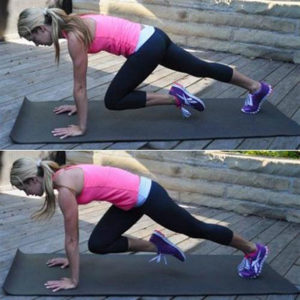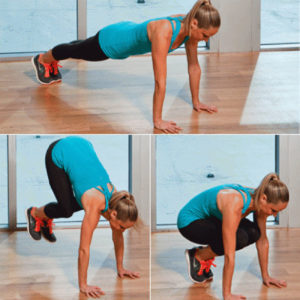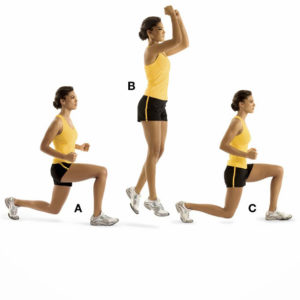The 3 steps to a flat stomach: eat right, burn more calories, and do core exercises. Here’s how to get a flat stomach fast by doing all of the above right.
Spending hours at the gym but still can’t seem to get rid of that extra belly fat? To get a flat stomach you have got to burn calories. To burn calories fast, you have to move. The harder and faster you move, the less time you can keep it up. That’s why intense, short cardio is the best way to flatten your stomach.
Everybody has a six-pack if not a flat stomach. For most of us, however, that six pack is hidden under a rather thick layer of adipose tissue. In order to let our abs see the light of day, we have to burn off the fat first. That involves 3 key elements:
1) A clean eating plan – abs are made in the kitchen!
2) An effective cardio program based around high intensity interval training to burn maximum fat during and after your workout.
3) Targeted core exercises to sculpt your abdominal area.
By itself, then, the world’s greatest ab routine will never allow you to get a flat stomach. In tandem with a sensible eating plan and a 3 x per week cardio routine, however, it will slim and sculpt a core to be proud of. With no further ado, here’s how to get a flat stomach fast:
Let’s consider each of these 3 key elements to getting a flat stomach one at a time.
How to Get a Flat Stomach by Eating Better

Whoever came up with the phrase “Abs are made in the kitchen” sure knew what he was talking about. It doesn’t matter how hard you work out, if you haven’t nailed your eating plan, you will never get a flat stomach. Here, in a nutshell, are the keys to getting your nutrition right:
1. Eat Every 3 Waking Hours
Forget about the traditional 3 meals per day eating plan. It is bad for you. From now on, you will eat more often and on a regular schedule. Each meal will be about the same size. Following this pattern will:
- Provide a steady flow of fuel and help to keep up your energy levels
- Help to reduce appetite, control cravings, and prevent binges
- Provide the extra energy you’ll need to power your workouts
- Boost your metabolism, allowing you to burn more calories while at rest
- Keep your body in an anabolic state 24 hours a day.
The average number of calories required by men to maintain their weight is 2,800 and 2,100 for women. To lose fat, reduce the total by 350 calories. That is an achievable, long-term restriction that will not leave you feeling depleted or deprived. Now that you have a total, divide it by the number of meals that you will eat throughout the day.
Example: Male aged 41. Total daily calories = 2,450. Meals per day = 6 (eating every 3 hours). Calories per meal = 2,450 divided by 6 = 408.
From here, you can work out your carbohydrate, protein, and fat requirements at every meal. Go with 50% carbs, 30% protein and 20% healthy fats. So, our 41 year old guy’s macronutrient breakdown per meal would look like this:
- Carbohydrate = 1,225 calories total or 204 calories per meal
- Protein = 735 calories total or 123 calories per meal
- Fat = 490 calories total or 82 calories per meal
- Avoiding foods that are deep fried in oil
- Avoiding trans fats, hydrogenated and partially hydrogenated foods
- Reducing your intake of saturated fats
- Increasing your intake of Essential Fatty Acids (EFAs) – especially Omega-3. Eat fatty fish such as salmon, trout, sardines and herring
- Increasing your consumption of avocados which contain EFAs
- Eating plenty of nuts and seeds.

Make sure that you are getting a high quality protein source with every meal. You should be taking between 25 and 40 grams of protein with every meal (divide your body weight by 6 to work out your individual number). Take protein in the form of a shake 20 minutes before and directly after your exercise sessions.
5. Eat Natural, Unprocessed Carbohydrates
Contrary to recent media reports, carbs are not your enemy. They are, in fact, your body’s preferred energy source. Cut out all processed carbs – focus on those made with white sugar and white flour. Make sure that you eat both starchy (grains and starchy vegetables) and fibrous (leafy greens) carbs at each meal. Fill up your plate, however, with more fibrous and fewer starchy carbs. Eat fruit every day.
6. Drink More Water/Cut Back on All Other Drinks

Yes, you’ve heard it before, but this time take it on board. Carry a water bottle with you everywhere. Sip it every 15 minutes or so. If you are a man, you should be taking in 3.5 liters of water each day. Women should target 2.5 liters. That may seem like a lot and it is. Work up to it. You will not have a desire for other drinks when you up your water intake That’s good. Sodas and fruit drinks are swamped with sugar. So is alcohol. Cut back on it if you are serious about getting in shape.
7. Schedule a Cheat Meal
Food is not only fuel; it is also a pleasurable experience. Plan to stick to the above 6 steps religiously 90% of the time. A cheat meal will allow you to eat whatever you want without feeling guilty about it. Just make sure that your cheat meal is confined to that 10% of the time and is scheduled into your nutritional program.
How to Get a Flat Stomach by Burning More Calories with Cardio Exercises
To get a flat stomach, you have to burn calories. To burn calories fast, you have to move. The harder and faster you move, the less time you can keep it up. That’s why intense, short cardio is the best way to flatten your stomach. High Intensity Interval Training will not only burn a ton of calories while you’re doing it, it will initiate the excess post-exercise oxygen consumption effect. This process will rev up your metabolism for 24-hours after your workout.Be aware that High Intensity Interval Training is hard work. You need to be prepared to push beyond your comfort zone – and then keep going. Never slow down, always dig deeper and don’t leave anything in the tank.
To perform this version of the HIIT training programme, you’ll be alternating between mountain climbers and three other movements to get in a 15 minute sweat session that will have you doing 40 seconds of work and ten seconds of rest for 18 rounds. Here’s what you’ll be doing:
Mountain Climbers

Starting in the plank position (extended arms on the floor, shoulder width apart, body flat, legs straight and together), as if you were starting a sprint. Now alternate bringing your knees to your chest, going as quickly as possible. Keep your back flat and butt down. Continue for 40 seconds.
Rest 10 seconds
Scissors
From the same starting position, jump your feet out as wide as possible. Now return to the starting position. Keeping control and your butt down, repeat as many times as you can in 40 seconds.
Rest 10 seconds
Mountain Climbers
Rest 10 seconds
Tuck Jumps

From the same starting position, jump forward with both feet together. Your knees should come as far forward as possible. Return to the starting position.
Rest 10 seconds
Mountain Climbers
Rest 10 seconds
Fork and Knife Jumps
From the same starting position, with your feet together, jump toward the right hand. Return to the starting position and jump to your left hand. This is different to tuck jumps because you are moving at an angle.
Rest 10 seconds
Mountain Climbers
Rest 10 seconds
How to Get a Flat Stomach Faster by Doing Core Workouts
To get a flat stomach, you are going to have to give some serious attention to the muscles of your core. It’s interesting to note that the best way to hit the muscles of your core (that’s the abdominals, obliques, and spinal erectors) is not to focus exclusively on exercises that target them directly.Compound exercises that work both the legs and the upper body have been shown to be more effective than the traditional abdominal exercises like crunches and sit-ups when it comes to achieving that flat stomach look.
The following circuit requires nothing more than a pair of light (2-5 lb) dumbbells and a bit of space. It involves 6 exercises, which are performed sequentially with no rest between them. At the end of the circuit, take a 2 minute break and then repeat the circuit 2 more times. This workout should be performed 3 times per week on alternate days.
The Workout:
Jumping Split Lunges

Standing feet together and with hands on hips, bend your knees and jump up landing with your right foot in front of you and your left foot behind. You’ll want to get as deep a bend in your knees as possible. Do 12 reps per leg.
Halo Deadlift
Grab a light dumbbell and squat down fully with the weight hanging between your legs. Keeping your back arched rise to a standing position as you lift the weight and rotate it around your head in a circular motion. Return to the start position and repeat. Do 12 reps.
Dumbbell Rotational Jumps

Start in the same position as the previous exercise, but this time the dumbbell should be held in a top curl position. From a bottom squat, perform a rotational jump that allows you to spin 180 degrees before landing. Jump from the bottom position into your next rep. Do 12 reps.
Elbow, Plank, Row
Start by lying on your stomach in a plank position, resting on your elbows. The only points of contact with the floor should be your toes and forearms. Position a pair of dumbbells on the outsides of your arms. One arm at a time, rise up to grab the dumbbells. Now pull the dumbbell in your right hand towards your chest. Repeat with your left hand. That’s one rep. Do 6 reps.
Mountain Climbers
Start in a traditional push-up position while keeping your core tight. Bring one knee up as close to your chest as possible while balancing on the opposite foot, and then quickly switch legs. Keep your butt down and your palms on the floor at all times. Do 12 reps.
Plank

Lie face down on the floor and prop yourself up on your elbows so that your body is supported only by the balls of your feet, elbows, and forearms. Keep your back straight in one solid line. Hold this position for 30 seconds.
Flat Stomach Benefits

While it’s great to be able to fit into your jeans again, the biggest benefit of training the core is safety not aesthetics. Virtually every movement we make, from getting out of bed in the morning to reaching up for a jar in the pantry, requires use of the core muscles. Strong core muscles can prevent a litany of problems in your life now and in the future. These include lower back pain; sprains, strains and tears; and muscular imbalance.
Source: healthdigezt.com














0 comments:
Post a Comment